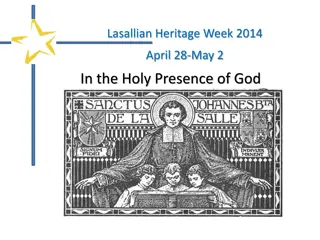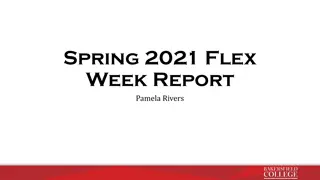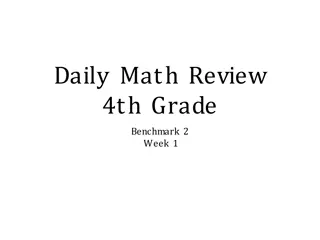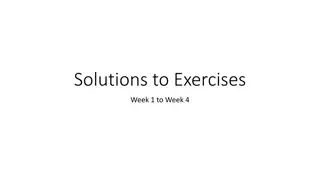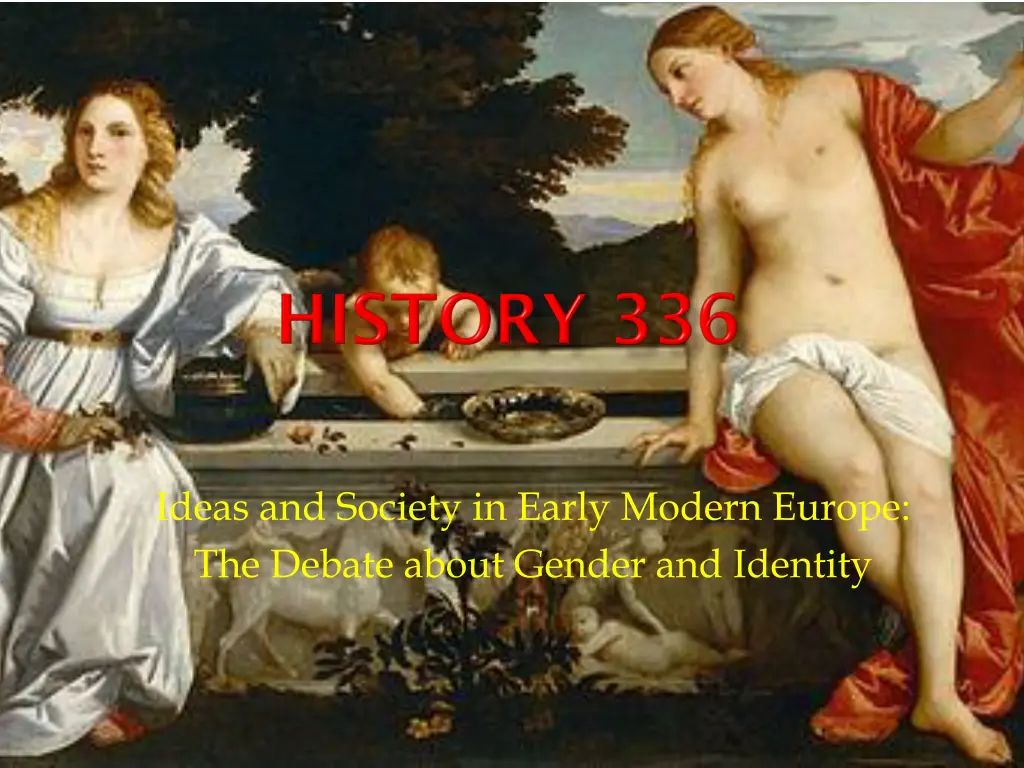
Gender and Identity Debate in Early Modern Europe
Explore the debate about gender and identity in Early Modern Europe through discussions on the rise of women's history, feminist movements, and the relevance of the early modern European period. Discover insights into social history, feminist critiques, and the significance of women's history in academia.
Download Presentation

Please find below an Image/Link to download the presentation.
The content on the website is provided AS IS for your information and personal use only. It may not be sold, licensed, or shared on other websites without obtaining consent from the author. If you encounter any issues during the download, it is possible that the publisher has removed the file from their server.
You are allowed to download the files provided on this website for personal or commercial use, subject to the condition that they are used lawfully. All files are the property of their respective owners.
The content on the website is provided AS IS for your information and personal use only. It may not be sold, licensed, or shared on other websites without obtaining consent from the author.
E N D
Presentation Transcript
Ideas and Society in Early Modern Europe: The Debate about Gender and Identity
Reading Value of attendance and participation Bring assigned readings to every class. Tests Written assignments: essays, annotated bibliography Consult the syllabus regularly and follow all instructions carefully. Learning objectives and course assessment Sophie Scholl, 1921-1943
Home page slides for lectures and tutorials Website for Women and Gender in Early Modern Europe: www.cambridge.org/womenandgender SFU Library Catalogue Databases: Historical Abstracts, ITER, ATLA, JSTOR, etc. Other Voice in Early Modern Europe [University of Chicago Press] Other Voice in Early Modern Europe [Toronto series] Librarians
At 9:30, Rebecca Dowson, the History liaison librarian, will give us a 30-minute presentation on how to use e-books at the SFU library. Bring your laptop / iPad / iPod or any other relevant device. You will probably find e- books very useful in History 336.
Sacred and Profane Love What are the origins of the painting? for the marriage of Nicol Aurelio (of Venice s Council of Ten) and Laura Bagarotto Why did I choose the painting as an emblem for the course? basic description enigmatic interpretation (title from eighteenth century) role of gender
How can we explain the rise of womens history? How does an analysis of gender enrich historical research? What does early modern Europe mean? Why is the early modern European period relevant for women s and gender history? What general conclusions can we draw from research into early modern women? What informs the structure of Wiesner-Hanks book? 1. 2. 3. 4. 5. 6.
increasing interest in social history feminist movements of the 1960s critique of women s history (1960s, 1970s) university courses in women s history SFU was the first university in Canada to establish a Women s Studies program (1975) thanks in part to Maggie Bentson
distinction between sex and gender: biology vs. cultural construction Joan Scott: gender is a primary way of signifying relationships of power (p. 3). Does it make sense to make the distinction? Queer Theory (1990s) challenges the distinction: sexual attitudes / practices / identities are in flux, not fixed or natural. dilemma for people who suffer discrimination by virtue of how they identify themselves
Is the distinction between male / female gender too simple? history of sexuality gay liberation movement, 1970s transsexuality / transgenderedness At what point in this process does a man become a woman, or vice versa? (p. 4)
linguistic / cultural turn (1980s): historical objective reality is impossible; find discourses in texts Does it make sense to refer to women (or men) as objective realities if gender is performative? dilemma: for women s history and justice
a revision to threefold schema: ancient, medieval, modern no exact temporal parameters, but 1500-1789 discontinuities and continuities geographical indeterminacy of Europe
idea of Europe importance of identity gendered origins: myth (rape or abduction by Zeus) or legend (marriage to king of Crete)
A fresco at Pompeii (before 79) Titian, The Rape of Europa (1562) Rembrandt, The Abduction of Europa (1632)
querelle des femmes: protracted and complex debate about gender and identity explosion of research women worthies (p. 11) all women Natalie Zemon Davis (1928 Merry Wiesner-Hanks (PhD, 1979)
The historical experience of early modern women was much less uniform than we thought it was several decades ago (p. 12) The role of gender in determining the historical experiences of men and women varied over time and from group to group (p. 12) Every question that has been asked and is being asked about the female experience must also be asked about the male (p. 13). 1. 2. 3.
Ideas Part 1: Body Part 2: Mind Part 3: Spirit Gender and power/ gender and colonialsm
In what primary sources can we find early modern ideas about women? What was the legacy to early modern Europe of the notions about women from Greek philosophy, Judaism, and Christianity? What problem was at issue, and what were the conflicting positions in the debate about women from the fifteenth to the eighteenth centuries? In the Reformation era, what were the contours of Protestant, Catholic, and Jewish discourses about women? Why did the Scientific Revolution do little "to challenge existing ideas of the inferiority of women" (38)? In what ways did laws affect women? What principles informed these laws? 1. 2. 3. 4. 5. 6.
religious literature, sermons marriage manuals household guides pamphlets and books on the querelle des femmes philosophical treatises plays poetry scientific treatises law codes, court records woodcuts / engravings
opinions regarded as religious truth or scientific fact (p. 18) authors: mostly men Men were much less willing to generalize about their own sex than about the opposite one, but underlying all their ideas about women, and the laws that resulted from those ideas, were concepts about their own nature as men (pp. 48-49).
inferiority Aristotle (384-322 BCE): women as imperfect men (p. 22), misbegotten males (p. 38) deformities man s best friend was a man Jewish traditions: wife, mother, impurity creation of man and woman New Testament: ambivalence: Jesus in Gospels; epistles ancient Christianity: emphasis on virginity
medieval philosophy / theology (scholasticism) Blessed Virgin Mary Eva vs. Ave unattainable ideal medieval courtly love more positive view of women but passivity (p. 23)
relationship with men: inferiority or equality a literary game ? (p. 26) Giovanni Boccacio (1313-1375) De mulieribus claris (Famous Women) Christine de Pizan (1364- ca. 1430) City of Ladies (1405)
Renaissance humanists: education but not equality Erasmus of Rotterdam (d. 1536) Juan Luis Vives (d. 1540) Heinrich Cornelius Agrippa of Nettesheim (d. 1535), The Nobility and Excellence of the Female Sex (1529)
Some female contributors: superiority or equality Lucrezia Marinella (d. 1653), The Nobility and Excellence of Women and the Defects and Vices of Men (1600) Marie Le Jars de Gournay (d. 1645), The Equality of Men and Women (1622)
Some male contributions defence and misogyny catalogues of female worthies, female vices Edward Gosynhill, The Schoolhouse of Women (1541), The Praise of All Women (1542) Controversy: Joseph Swetnam, The Arraignment of Lewd, Idle, Froward and Unconstant Women (1615) Rachel Speght, A Muzzle for Melastomus (1617)
Views from the eighteenth-century Enlightenment unequal and limited education (p. 41) and women s limited contributions to science and philosophy Marquis de Condorcet (d. 1794) favours equality Jean-Jacques Rousseau (d. 1778) maintains the radically different natures of men and women
Protestantism: spiritual equality, value of marriage, call to marriage and motherhood, obedience to husband It is important to recognize, then, that the Protestant elevation of marriage is not the same as and may, in fact, directly contradict an elevation of women as women (p. 33).
Catholicism: superiority of celibacy / chastity, a slight advantage over Protestantism?, women as allies in the quest for conversions to Catholicism Judaism: importance of marriage, superiority of husband
debates about physiology Aristotelians vs. Galenists: a woman s contribution to conception Aristotelians vs. Galenists: physical imperfection vs. perfection in sexual difference embryology: spermatic vs. ovist positions four humours: blood (hot), phlegm (cold), black bile (wet), yellow bile (dry). Women were more cold and wet than men Power of uterus: hysteria entrenchment of inequality
Linda Shiebinger has pointed out that the acceptance of Galenic ideas of the complementarity of the two sexes, far from leading to greater egalitarianism, led instead by the end of the eighteenth century to the idea that gender differences pervaded every aspect of human experience, biological, intellectual, and moral (pp. 38-39).
Laws thus reflect male notions and worries more than real female actions (p. 43). marriage and legal inferiority Implication: women cannot function as legally responsible persons. spread of Roman law absolute control of father honour = a sexual matter (p. 48) Men had to help women defend their honour.










